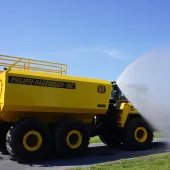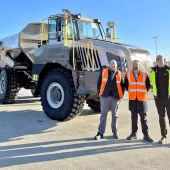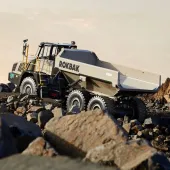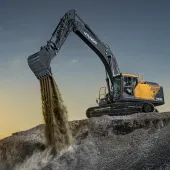Shaping The Future
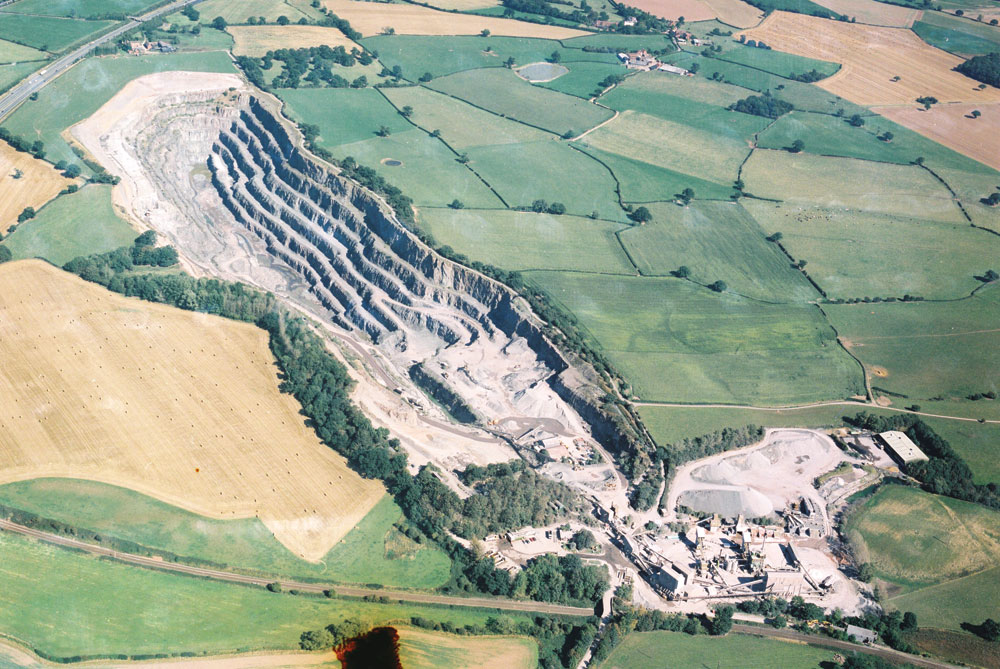
New Caterpillar 775F dumptrucks to play a key role in development plans at Bayston Hill Quarry
Bayston Hill Quarry, on the southern outskirts of Shrewsbury, part of Tarmac’s Western area, has recently embarked upon a major 30-million-tonne extension project designed to secure the future of this nationally important site for the next 55 years. Subject to the granting of planning approval, the multi-million pound project, which is scheduled to take around eight years to complete, will involve the construction of a completely new dry stone plant, a new coating plant and a new stocking area, together with the creation of an extensive new perimeter landform to completely screen the quarry operations from view.
Currently, the 57ha quarry has a large and complex 300 tonnes/h fixed processing plant comprising six crushers, 14 screens and various connecting conveyors, while its mobile plant fleet includes the first two 64-tonne payload Caterpillar 775F rigid dumptrucks to arrive in the UK, together with a 60-tonne Komatsu PC600 excavator in backacter configuration. These three prime movers, all of which are on long-term hire from South Wales-based Walters Plant Hire, perform front-line load-and-haul duties on a cost-per-tonne basis, while stocking, secondary and ancillary operations are undertaken by four articulated dumptrucks and three loading shovels of varying sizes.
Operating 10h a day, five days a week, and employing 38 people directly, Bayston Hill produces approximately 850,000 tonnes a year of high-PSV red and grey gritstone (greywacke), while its two asphalt plants, between them, produce around 250,000 tonnes a year of coated materials. In addition, the site’s washing plant, which is operated on a seasonal basis, produces 60–70,000 tonnes a year of washed aggregates. The site has a total stockpiling capacity of around 100,000 tonnes, much of which is built up during the winter months in readiness for increased demand in the spring and summer.
Approximately half of Bayston Hill’s output is delivered within Shropshire using the 35-vehicle owner/driver fleet based at the quarry, with the bulk of the remainder being collected from site for use in asphalt production across the UK. Single-size aggregate from Bayston Hill has even been shipped as far afield as Bahrain, where it was used to surface the kingdom’s new Formula 1 race circuit in 2004, and the quarry has also recently secured a similar deal for the new F1 circuit currently under construction in Abu Dhabi.
With around 15 million tonnes of existing reserves still remaining, extraction operations at Bayston Hill have been somewhat constrained lately in anticipation of the site’s proposed extension, with more frequent but significantly smaller blasts than usual being employed to prevent the sterilization of potential future reserves. This, in conjunction with the distinctly linear nature of the quarry – the void measures 1.25km in length and just 300m in width at its widest point – has presented the site management with considerable operational difficulties in recent years.
In seeking to extend the site, Tarmac are aiming to gain access to a considerable volume of additional stone with relatively little widening of the existing void. At present the base of the quarry sits at a level around +4m AOD and the current maximum achievable depth is 12m below ordnance datum. However, by increasing the width of the void by a further 120m, it will ultimately be possible to drive the base of the quarry down to a level some 72m below ordnance datum, thereby releasing a further 30 million tonnes of reserves and securing ongoing operations at the site until the early 2060s.
To satisfy the wishes of the local planning department, who were keen to see Bayston Hill’s the processing plant and stocking area (the most visible parts of the site) completely enclosed and obscured from view, Tarmac have devised an ambitious seven-year scheme involving the progressive stripping of around 3 million cubic metres of overburden and the creation of a new landform/screening mound along the south-eastern perimeter of the site. The existing processing operations will be removed and the plant area restored, and a new plant and stocking facilities will be created at a lower level within the new mound. Apart from its access road, the quarry will then be effectively hidden from view from all directions.
The new screening mound itself will become a significant feature in its own right, with a public footpath along its top giving views over Shrewsbury to the north and the Shropshire hills to the south, while the land on and adjacent to the mound will be restored to a mix of woodland and low-intensity pasture and managed in accordance with the quarry’s biodiversity action plan. The extension scheme also includes plans to re-establish a former rail link to the quarry, utilizing an existing but long-abandoned rail siding that links the quarry to the Crewe to Newport main line. This will be reopened and upgraded, allowing 200,000 tonnes of material to be dispatched by rail each year.
Thanks to Tarmac’s support for local community projects, and the sympathetic and responsive way in which Bayston Hill’s management and staff react to any problems and issues relating to the site, public opposition to the proposed extension scheme has been minimal. As far as possible, the site has always endeavoured to fit in with the local community, and the effectiveness of this approach was attested by the 3,000 visitors who attended the quarry’s open day in 2007 and the 300–400 school children who visit the site every year. The planning application process has also benefited from extensive and ongoing consultation at various levels, together with regular liaison committee meetings and visits to individual residents whenever specific issues arise.
In particular, extensive use of 3D modelling and computer-generated images of proposed future views and sightlines helped to reassure the residents of nearby Beton Strange that, although the extension will result in the overall footprint of the site moving closer to their village, the new operations will be fully screened from view by the new landform feature.
The planning application for the extension went to the Planning Committee of Shropshire County Council in March 2007 and, having received unanimous support from the Council with no objections being raised, a resolution to grant was confirmed by the Committee. Formal planning permission for the extension scheme is now expected imminently.
New Cat 775F dumptrucks
As with current operations at the site, a key factor in the ongoing success of the quarry as it reshapes itself for the future will be the performance and effectiveness of its mobile plant, in particular its prime movers. ‘In seven or eight years’ time, when the new crushing, screening and coating plants are in place, we anticipate producing similar volumes to today but processing them a lot quicker, or we may be producing larger volumes but in the same time frame as today,’ explained quarry manager Huw Evans. ‘But whatever happens, the prime movers, especially the dumptrucks, will have to be able to keep up.’
Supplied by Finning (UK) Ltd to Walters Plant Hire in July 2007, and then delivered to Bayston Hill as replacements for two earlier Cat 775Es, which had themselves superseded three Cat 771s some four years earlier, the new 775Fs are loaded in six passes and complete the current 800m haul (1,000m maximum) from the face to the primary crusher and back in an average cycle time of 15min.
‘Cycle times, haul distances and haulage routes have all got to be properly planned, managed and run to ensure the quarry continues to operate efficiently, which is why we’ve spent a lot of time designing the initial development phase for the extension, working out how to get the rock from the face to the crusher in the most efficient way,’ said Mr Evans. ‘It’s fair to say that the two new Cat 775Fs are going to play a central role in this process going forward.’
Designed for quarry applications in the 64-tonne payload class, the Caterpillar 775F rigid dumptruck incorporates many new features designed to enhance machine reliability, durability, productivity and operator comfort and safety, while at the same time lowering owning and operating costs. These features include a new engine, enhanced transmission, all-hydraulic brakes and a new operator station.
The truck also offers particularly well-designed access and egress facilities for the operator and service personnel, while a new information system, Cat Messenger, enhances both maintenance and machine information for technicians and operators alike by providing valuable real-time and stored machine performance and operating data, as well as basic trip, maintenance and diagnostic data via an in-cab LCD display.
‘The on-board computers give us a raft of information, including idling time, number of loads completed, and fuel usage per mile,’ said Mr Evans. ‘This gives us a heightened awareness of our fuel costs and helps in designing the quarry in order to get the best out of the machines. It really is the next level of best practice in cost-per-tonne analysis.
‘The system also cuts out a lot of manual form-filling of management information, and helps us to identify individual operator habits and examples of poor practice, such as always reverse turning in one particular direction, which can result in uneven tyre wear.’
For increased reliability and durability, the 775F’s frame has been redesigned using a mild steel box-section frame with two forgings and 19 castings to evenly distribute stresses, while for optimum capacity and reduced cost per tonne, the truck is offered with optional dual-slope or flat-floor dump body systems, together with three different steel liner packages and two rubber liner packages. Two-stage hoist cylinders provide a 9.5s body raise time and a 12.5s body lower time.
The 775F is powered by a turbocharged and after-cooled 12-cylinder Cat C27 engine, which delivers a gross power output of 587kW (787hp) at 2,000 rev/min. In addition to ACERT Technology for fuel-efficient operation, emissions compliance and improved response, the engine features the Cat MEUI fuel system, which combines advanced electronic control with direct mechanically controlled fuel injection. The pairing of the C27 ACERT engine with Caterpillar’s seven-speed electronically controlled powershift transmission delivers constant power over a wide range of operating speeds up to a maximum 42 miles/h (67.4 km/h).
With regard to braking efficiency and stopping power, in order to achieve a high level of response, control, modulation reliability and serviceability, the 775F’s front dry disc and rear oil-cooled multiple disc brakes are now fully hydraulically controlled, and the parking brake is integrated into the gear selector for ease of operation.
Moreover, automatic retarder control (ARC), which is standard on the 775F, automatically controls braking on grade and maintains engine speed at approximately 1,900 rev/min. This eases the burden on the operator and helps maintain optimum engine speeds for up to 15% faster downhill hauls. ARC, which is deactivated when the brakes or throttle are applied, also protects the engine from over-speeding and helps improve fuel efficiency. In addition to the standard automatic retarder, an optional engine compression brake offers a 35% increase in retarding speed capabilities.
According to Caterpillar, the efficient combustion technology of the ACERT engine reduces operating costs by doubling the engine service interval from 250h on the earlier 775E model to 500h on the 775F. In addition, QuickEvac, the Caterpillar on-board engine oil evacuation and pre-lube system, is fitted as standard to reduce oil change downtime by as much as 50%, while overall serviceability has been improved by the grouping service points in easy-to-access locations.
Thanks to a dedicated customer support agreement between Walters Plant Hire and Caterpillar dealers Finning UK, servicing of the two 775Fs at Bayston Hill is largely carried out by Finning engineers from Cannock, although Walters also have a locally based fitter who visits the site and liaises with Tarmac and Finning on a regular basis. As part of the customer support agreement, Walters also work with Finning to perform preventative maintenance, in particular using their scheduled oil sampling to help prolong vehicle life and reduce operating costs.
To enhance operator comfort, safety and control, the 775F cab has 100% more glass area for improved visibility, 18% more interior space, more than 175mm extra width and a lower interior sound level than the previous E-series model. In addition, a new, ergonomically designed control layout helps to promote efficiency and reduce operator fatigue, while the Cat Comfort Seat with its three-point operator restraint system is now mounted in the centre of the cab to provide additional space and ‘walk-in’ comfort. The 775F also features new a heating, ventilation and air-conditioning system, which produces greater airflow and delivers a more even temperature throughout the cab.
A key feature of the 775F is its wide, 45° integrated main stairway with hand/guard rails and slip-resistant surfaces. This allows safe and easy access to and from the truck, while another stairway on the left of the machine provides secondary access/egress. A stairway lamp illuminates the cab access stairs and can be activated both at ground level and from within the cab. Large, heated wide-angle mirrors are also fitted as standard, and an optional camera system provides a clear view to the rear of the truck via a colour LCD monitor in the cab.
The final word on the new trucks goes to one of Bayston Hill’s Cat 775F drivers, who was particularly impressed with the truck’s new safety features. ‘The vehicle is much easier and safer to climb into and out of, and offers far better all-round visibility that the previous model,’ he commented. ‘The new cab is larger, more comfortable and significantly quieter; in fact, the sound-proofing is now so good that the shovel operator has to activate a radio alarm when the truck is fully loaded, because it’s no longer always possible to hear the toot of the excavator’s horn!’
Acknowledgements
The editor wishes to thank Tarmac for permission to visit the site and, in particular, Malcolm Lawer, estates manager, and Huw Evans, quarry manager, for their help in preparing this article.


